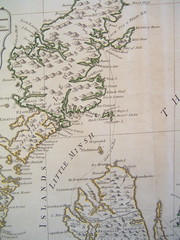How Information Won’t (and Will) Save the Climate: The Perspective of History
Each profession has its approaches to climate
change: scientists ponder why, despite the marshaling of data, nothing has been
done, their arguments subjected to public doubt and legislative apathy. Economists and political scientists mull over
"tit for tat" strategies and "free rider problems,"
tinkering towards some hypothetical consensus that would persuade all
constituents, industrialists, consumers, poor countries, and rich ones, to
implement solutions for dealing with climate change. Meanwhile,
historians look backwards and wonder: will more data actually do anything? Is it actually in the power of tinkering
legislators to reframe climate initiatives in some perfectly persuadable
language? Made skeptical by their knowledge
of failures past, historians question the collection of data, reformist
legislation, market solutions, and mass mobilization as equally impotent
against the problem of climate change.
Stories about reform movements past give us
reason to pause. Three generations ago,
historians like Oliver Macdonaugh thought that merely amassing more data could
solve any problem and they talked about the successive reform movements of the
nineteenth century -- getting the children out of the mines, increasing
literacy, combatting alcohol, legislating workmen's compensation -- as a
history of data-gathering in the service of progress. Now, we have become more wary. It seems as if too much data-gathering by
experts may itself obscure the issue: we write about "information
overload" that afflicted botanists in the early renaissance and
geographers in late Victorian empire. We
write about "unintended consequences" of "expert rule," for
instance when British engineers on the Suez canal dismantled local systems of
water management and so accidentally initiated the massive spread of
malaria. Our understandings of the
urgency of climate change issues come at the tail end of a long list of late
twentieth-century failures of reform movements -- including the never-adopted
human rights campaigns of the 1970s, the Green Revolution with its failed
promises for international food security, and indeed projects of world
governance and the role of the United Nations in general. Twentieth-century organs of government have
been, it seems, particularly awful at getting things done at a global scale.
Historians agree: climate change is not unique, not merely a difficult
intellectual problem, not simply another issue requiring more data. If history is any rule, the news is bad: no
magical groundswell is coming in politics to destabilize the status quo, for
the overwhelming reform movements characteristic of the nineteenth century are
a thing of the past, coopted by party politics and back room deals. No amount of data accumulation by scientists
will change how business is transacted, as data accumulated by science is just
as likely to be used by big business for greenwashing or to limit returns. A swarming of business solutions through tax
incentive programs will create low-emission zones of clean air for the rich,
while dirty forms of manufacturing and energy production are shipped offshore,
and carbon levels continue to rise, imperiling our collective future.
But historians make a habit of thinking about
drastic changes in the institutions of governance, of the kind signaled by
transitions out of feudalism. Climate
governance of the kind imagined by environmentalists -- gigaton solutions,
geoengineering, massive transformation of transportation -- is similarly an
alternative paradigm of collective care for land, water, and air as a
commons. It requires new institutions
and new forms of governance, ones likely resembling the common-property
institutions described by Elinor Ostrom in her latitudinal survey of successful
fisheries, forestry management programs, cooperative housing associations, and
grazing commons around the world.
The nearest historical precedent for such a
shift towards communal management in the modern world comes from the
late-nineteenth century land reform movements that gave us a wholesale plan of
collectivizing the urban environment.
Reformers pioneered the creation of public utilities, rent control,
public parks and playgrounds, allotment gardens, and public housing. They argued for the opening up of private
foot-paths to the public. Once forgotten, these movements are again attracting
scholarly attention, for in their ambitions of equitably distributing the
management of land and water, our ancestral movements resemble those among
environmentalists today.
Then, as now, environmental crises were linked
to an overwhelming array of interconnected problems, patched over by interim
work of part-time reformers, wealthy patrons, and corporate do-gooders. At the end of the nineteenth century, concern
over interwoven problems of urban cities -- unemployment, overcrowding, public
health, and poverty -- generated the invention of new forms of governance for
the collective management of the urban environment. At the heart of these transformations were
new interpretations of law, city and regional government, and the visualization
of data. Likewise, ahead for today's
environmentalists are transformations of law, regional and international
government, and the instrumentalization of data, capable of responding to
already-visible groundswell movements demanding change.
Data is essential to this horizon, as is
the creation of a data architecture that enables institutions capable of
democratic rule. In economists' speak,
these institutions highlight the externalities involved with our
collective dependence on the vast, difficult-to-measure benefits of the
ecosystem. The laws that Ostrom
discovered replace a law of short-sighted protection of single-owner property
-- the kind of logic that creates what Garrett Hardin called the "tragedy
of the commons" -- with the collective monitoring of common-pool
resources, a kind of decentralized panopticon where participants monitor their
collective resources as well as each other, thus prohibiting resource
exhaustion.
History tells us a great deal about attempts to
reinstate commons and their successes and failures. Debates about climate change and the
administration of forests as commons began in the late 1970s and 80s, when
Ostrom was first collecting her case-studies and indigenous people around the
globe began well-orchestrated protests against their deracination from the
land. At the same time, radical development economists began to theorize how to
reinstate the commons, renew local institutions, and turn forests and aquifers
over from civil engineers to local, democratic bodies.
The major tool developed by these movements for
renewing the commons were a new kind of map: a crowd-sourced map made by a
dozen or a hundred participants, which allowed participants to synthesize
information about the way they related to the environment: where in the village
they lived, how they used water, whether they had access to existing
institutions around them. Organizers
would descend on a village, summon the children, elders, women, and extremely
poor, and spend a day with the community talking and drawing maps of the
village on the ground. They reversed the
paradigm of colonial governance: instead of the expert surveyor and civil
engineer mapping the ground to administer it from afar, now the people in the village
created a map for themselves which would serve as the basis for community
conversations about how best to reorganize the governance of land and water.
Today, similar crowd-sourced maps have been
deployed to create a groundswell of community-originated information about
pollution, sanitation, and responsibility.
In Kerala, India, high-school students map flower and frog species on a
google-based map, charting biodiversity in relationship to excreta dumped into
the lake by tourist boats. The maps
point to those responsible, and have enabled successful lawsuits. In Tamil Nadu, mapping has helped farmers
target tanneries whose effluents were polluting the aquifer. In the Philippines and Thailand and Canada,
groundswell indigenous movements armed with GIS have crowd-sourced folk
knowledge about territory to create multi-authored maps that stand, in court,
as proof of the tribe's claim to an ancestral property rights on the land. The crowd-sourced map has become a tool of
community administration of ecology, facilitating the targeting of irresponsible
behavior, the identification of a geographically-based collection of
stakeholders, serving to mobilize them with the power of graphic visualization
and offering a form of political and legal testimony deeply persuasive to the
judges and officials who see it.
This summer, I visited a dozen nonprofits
involved with mapping water management, fisheries, forests, irrigation works,
small farmers, transport, and city waste across India, some of them thirty
years old, some armed with smart phones and GIS. They are all doing good work, and many of
them are remarkably successful in terms of organizing local political campaigns
and lobbying city government.
We found two problems. One was a lack of ambition to scale. The historic initiatives were village-based,
with few ambitions to go further. Now,
empowered by modern GIS tools, the Gandhigram Rural institute is embarking on a
project to map 10,000 water-bodies in Tamil Nadu, and ATREE is mapping the 5th
largest lake in India. These initiatives
highlight the possibility of undertaking large-scale projects with these
techniques, but no one thinks larger than the size of an Indian state - at the
level of the nation or beyond. It is an
information architecture problem: the creation of a crowd-sourced map capable
of enabling political movements at larger and larger levels, contextualizing
local and state action within a global framework.
The second problem was a questionable
commitment to democracy. What we found
in India was a disconnect between the older generation of participatory mappers,
fiercely dedicated to equal distribution of economic benefits, and the newer
generation of internet-focussed mappers.
On the one hand are individuals now in their 60s or older who spend
their youth with squatters, mapping their residences in the Bombay slums so as
to petition local government to turn over property rights, or working with
indigenous tribes in the mountains to force the government to recognize their
occupancy. Their commitments to
democratic processes are unfailing; they know volumes about incorporating women
and working-class people into a mapping session, producing a new consensus
about administration within a village, or organizing a new institution to
administer water or pollution on the level of a watershed. On the other hand are a new generation of
Stanford-and MIT-educated CS or business majors, returning to India with the
promise of Google Maps and venture capital behind them. They too hear the promise of rich data about
the environment to adjudicate complex questions like the availability of
water. But they know almost nothing
about the previous generation's work.
Their training in economics leads them to optimism about how the
market's invisible hand will allocate water to the very poor. The tools they design are tools for enabling
cell-phone users equal opportunity to purchase water. More rarely do they think about learning from
India's political maps in the 1980s, and creating a smart-phone app that would
enable Americans to map their involvement in the globe's dirtiest
supply-chains.
Both of these, the problems of scale and of
democracy, are issues of information architecture. They can be solved with the power of
visualizations driven towards political organization. But mapping and code by themselves are not
enough. Climate change demands the
creation of new institutions of governance that follow Ostrom's paradigm of the
commons, with its understanding of collective responsibilities. These
institutions must be democratic, and served by an information architecture
stamped with participation.
For this to happen, the mapping, code, and data
collection must be allied to a sense of memory: both memory of the reasons why
expert rule in the past has gone so wrong, and memory of the amazing potential
that maps have had when allied to grassroots organizations among indigenous
people around the world. For those
reasons, scientists, coders, and entrepreneurs can help, but they need the
power of memory, the service of historians.
Memory is necessary, in order that we keep sight of and overcome the reasons
why environmentalism has thus far failed: the risks of information overload,
the corruption of privilege, and the inefficacy of expertise. Memory of the powers of information to unite
communities, the importance of democracy, and the successes of institutional reform
before us can thereafter be our guide.
(at the NSF-funded UC Davis workshop on Climate Change and Governance, Lake Tahoe)









